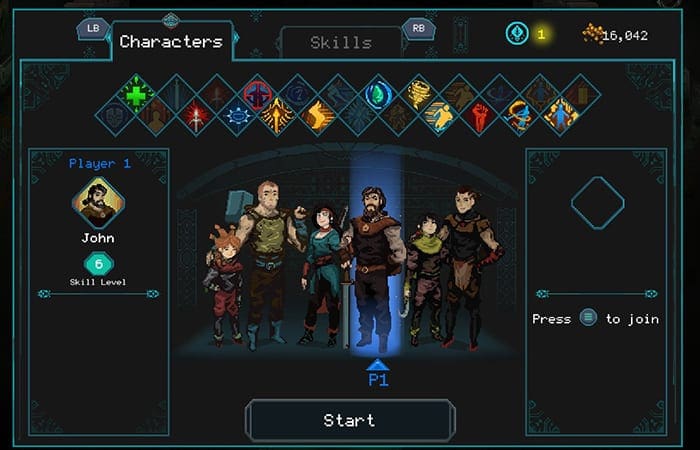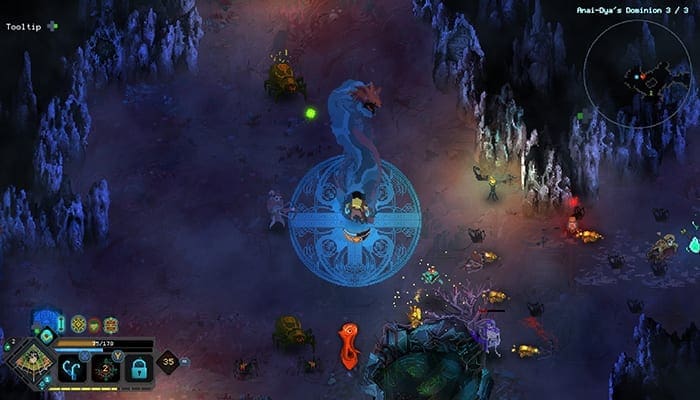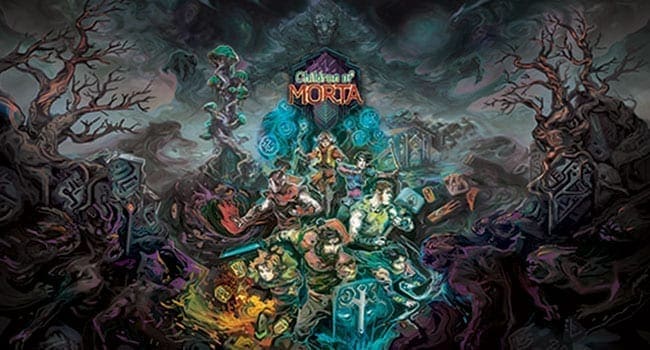
The Children of Morta character selection screen. In the beginning you only have access to the father, John. As you progress you gain access to more of the Bergson family. The diamond-shaped icons above the Bergsons are skills you can unlock that benefit the whole family.

Children of Morta
Developer: Dead Mage
PC, PlayStation 4, Switch, Xbox One
The gameplay in Children of Morta really shines. It’s fast, fun, satisfying and continually fresh. Unfortunately, that exposes the shaky story and weak world-building of this new game.
In Children of Morta, you take on the role of not one hero but an entire family, the Bergsons, who are destined to confront the forthcoming Corruption.
The god Rea is gone, Corruption is seeping into the world and it’s up to the Bergsons to find out why and stop it. You delve through caves and cities, seeking powerful spirits to help you discover what’s gone wrong.
It’s a roguelike game – a sub-genre of role-playing video games that borrows mostly from the 1980 game Rogue. Roguelikes vary but commonly have procedurally-generated levels. The levels are arranged differently each time you make an attempt – the maps are laid out differently, as are enemy placements.
Roguelikes are run-based, meaning you make an attempt at the level and see how far you get. Even if you don’t finish the level, you should feel like you’ve somehow progressed in every run.
In Children of Morta, this progression comes in the form of upgrades gained through experience points you earn, purchases made, or simply by refining your skill as a player.
The general loop of the game is this:
- choose a family member and venture into a level;
- gather bonuses, experience and money while attempting to complete the level;
- following either success or failure, return home to spend money on family-wide upgrades;
- repeat.
A good roguelike should make you feel like you’re getting somewhere even when you fail. Children of Morta nails this. Barring the fairly repetitive look, each run is fresh and it feels like you’re progressing. If you fail, you lose the temporary bonuses you’ve gained but you keep all the money you’ve earned and your chosen character keeps all their skill points and experience.
As you progress through a level, you gain items, bonuses and abilities, all of which remain until you either complete or fail the level. With each run you get a different collection of bonuses, so by the time you get to the boss, you will have a largely different tool set than you had in a previous attempt.
Although these bonuses are lost at the end of each run, your character can get permanent upgrades. Defeating enemies gains you enough experience for skill points. Skills are permanent and some even grant the entire family a bonus, encouraging you to hop around, try different characters and see what advantages they can earn the family. The characters play differently and each is fun.
The mounting list of permanent upgrades, temporary bonuses and increasing skill comes together really well. It all contributes to a feeling of meaningful progress.
I played with a PS4 controller hooked to my PC, but I also tried playing with mouse and keyboard controls. The controller was by far a better way to play but I found with the two ranged characters (one that shoots a bow and another that hurls fireballs) it was easier to aim their projectiles using a mouse.
I switched characters often but never because I was bored. Sometimes I changed because I had tried a couple times and was stuck, but mostly I switched to a new Bergson simply because it had been a while since I had played them. I looked forward to giving their mechanics another try and to see what interesting new skills I could unlock.
I would try a new character, get into a groove with them, try the level a couple times and then, if I hadn’t succeeded, I’d move to another character. They always felt fresh when I returned to them.
As an added bonus you can play with a friend. While playing two-player the camera struggled a little deciding who to follow, especially in the midst of frantic combat when you get separated from each other. But despite that, the option was a welcome addition and it I think I would enjoy playing through the game as a duo adventure.
The overarching story is pretty base-level fantasy fair: corruption spreading, your god is gone, it’s up to the chosen one (or chosen family) to defeat the big bad. The story’s not very engaging and it’s certainly not innovative, but it’s fine.
Children of Morta’s web page says the game deals with “themes closer to our daily lives tha(n) one would expect” such as “love and hope, longing and uncertainty, ultimately loss and (the) sacrifice(s) we are willing to make to save the ones we care the most for.”
Through its narrative sequences, the game tries to deliver on these themes. But its ham-fisted delivery means the emotional impact it seeks never lands.
The real stinker is the codex – the collection of journal entries and lore information you discover as you play. It’s riddled with poor sentence structure, bad grammar and typos. It seems like the whole thing needed another good pass from an editor. Let’s hope my editor saves me from any irony in that statement.
The real shame is that the developers are clearly trying to do something with the narrative. They break up the action between levels with cut-scenes and establish relationships between characters. Even the existence of the codex means they want us to care about the story. But the presentation and lack of polish in the narrative undermine the effort.
Nevertheless, I had a lot of fun with Children of Morta. Enough fun that as I write this, I have the itch to go back and play it some more. That seems like a good sign.

The youngest Bergson son, Kevin, surrounded by enemies. The large snake-like creature he is in the midst of summoning is a “Divine Relic” – a temporary ability that he has picked up during this run.
The views, opinions and positions expressed by columnists and contributors are the author’s alone. They do not inherently or expressly reflect the views, opinions and/or positions of our publication.


